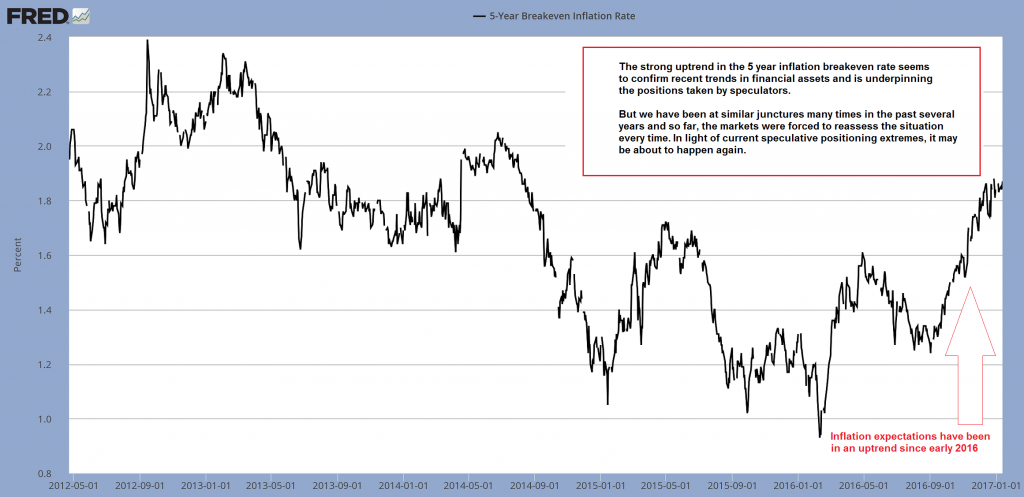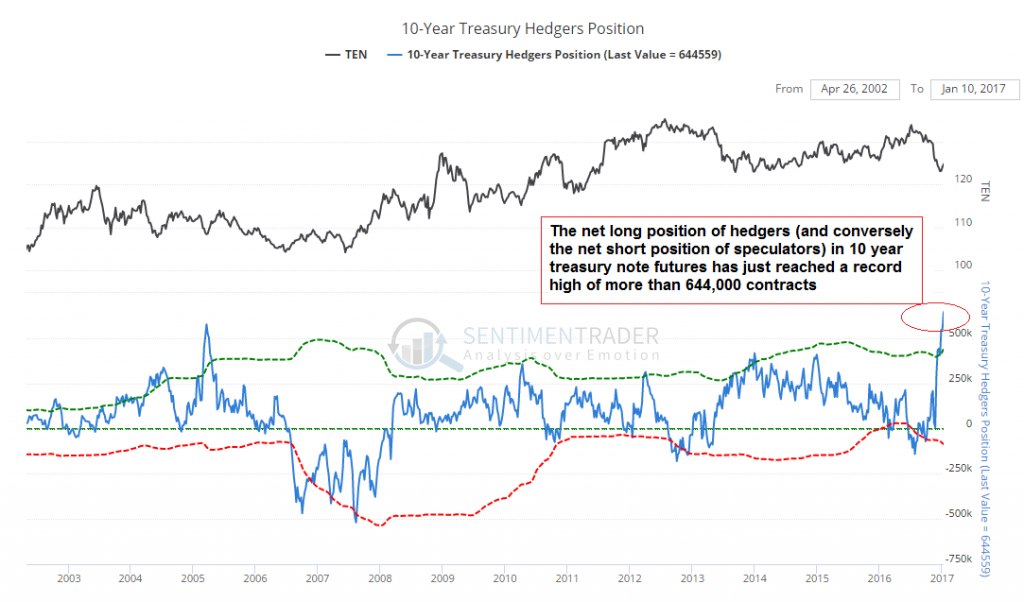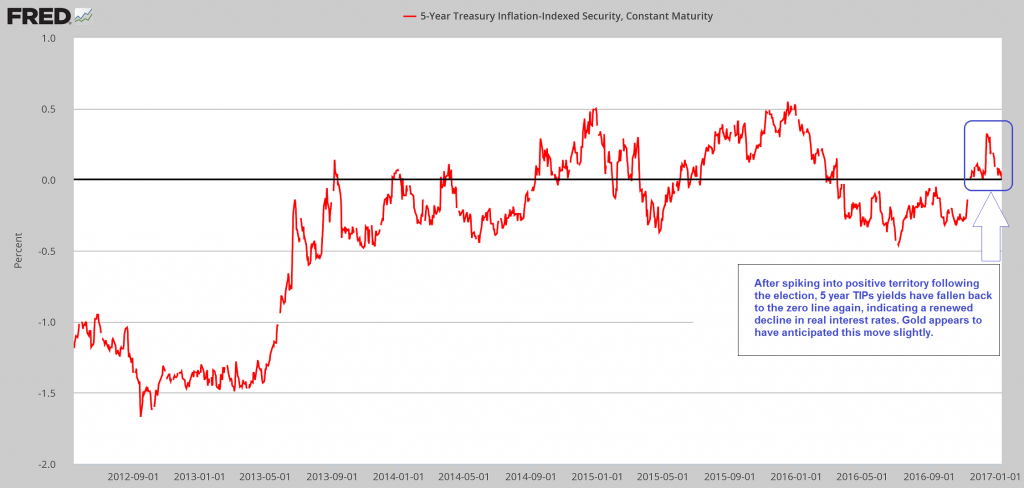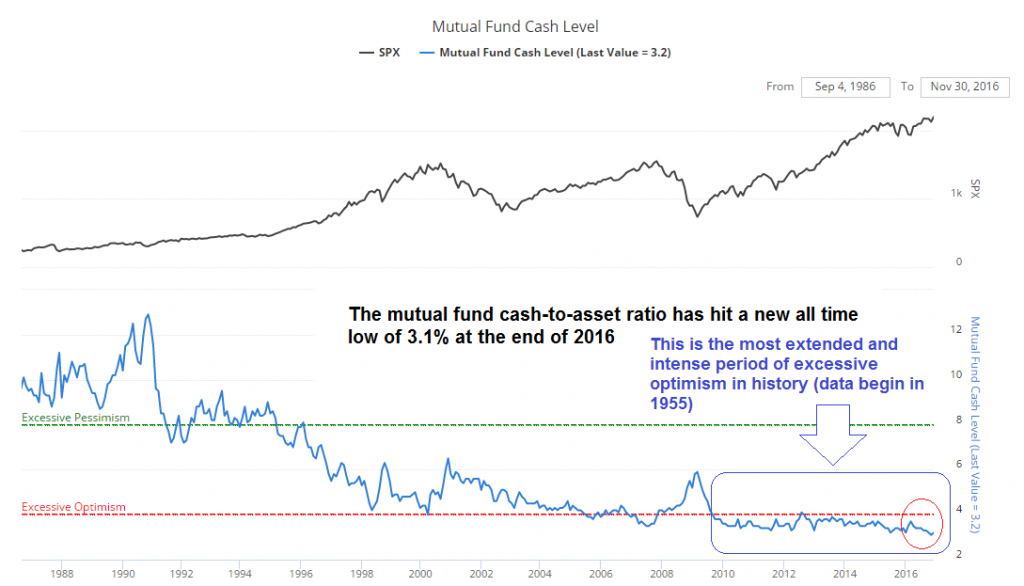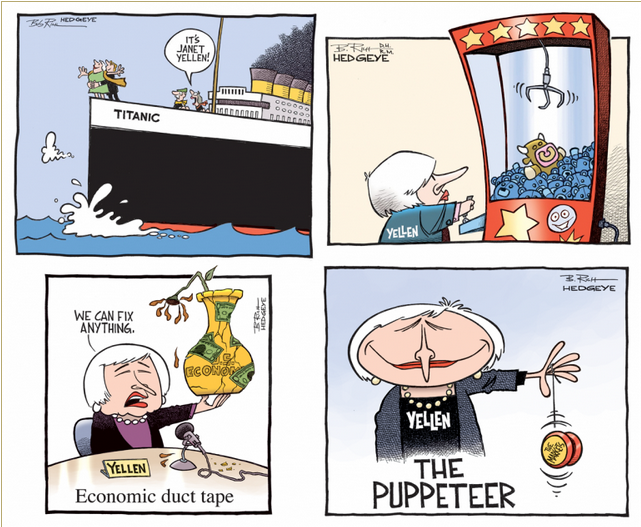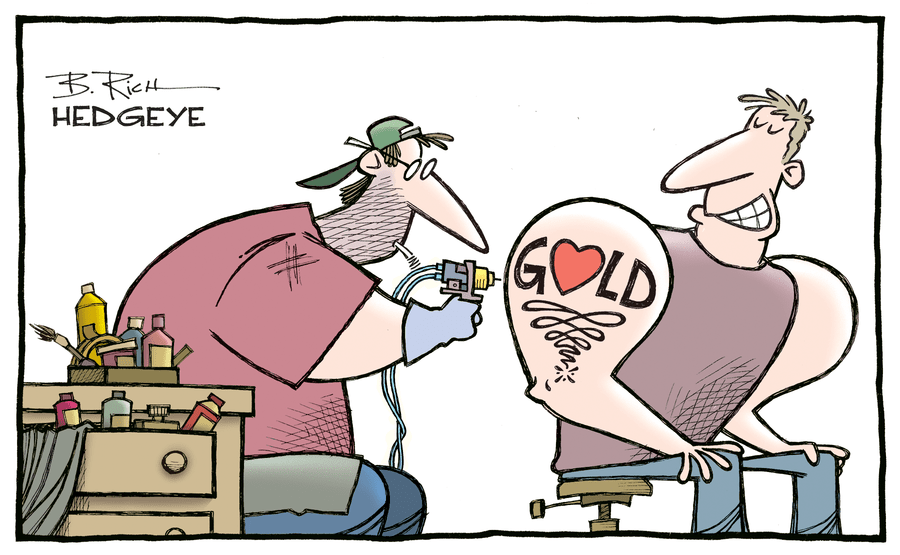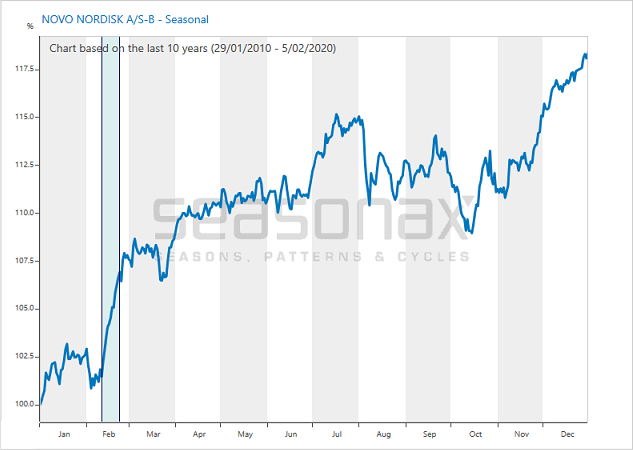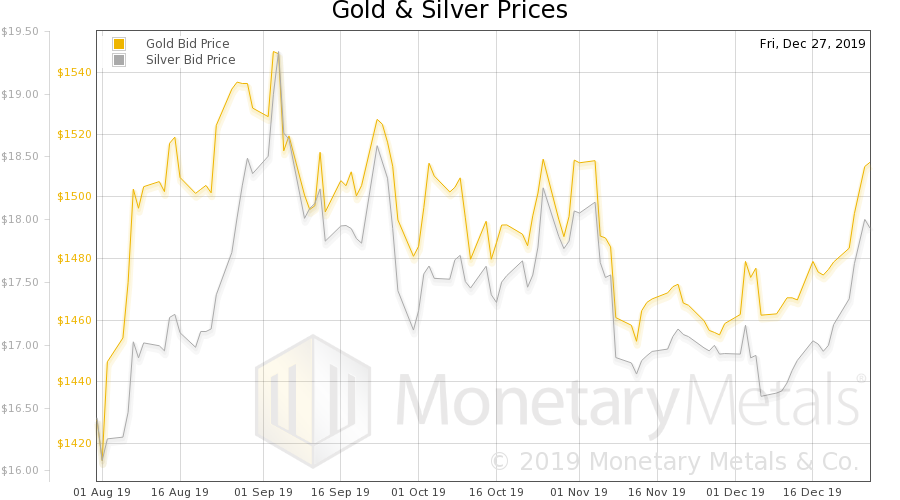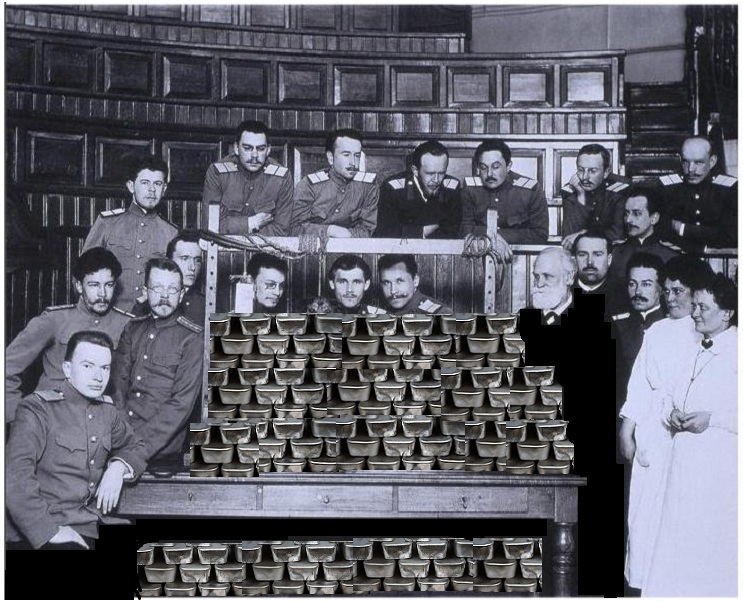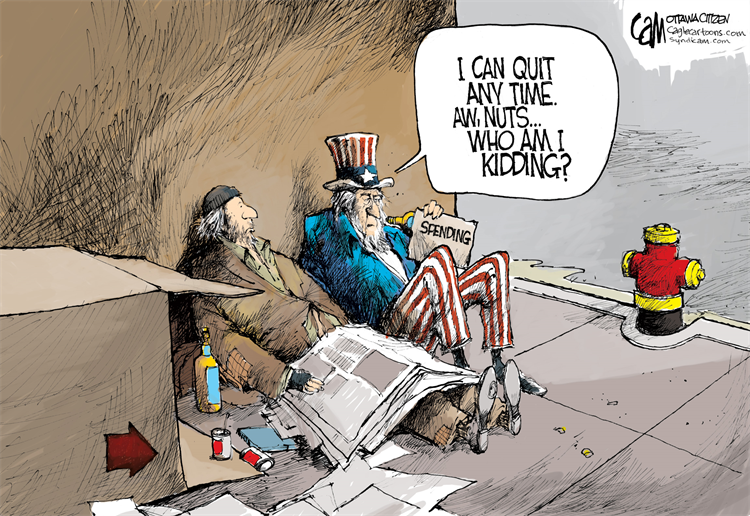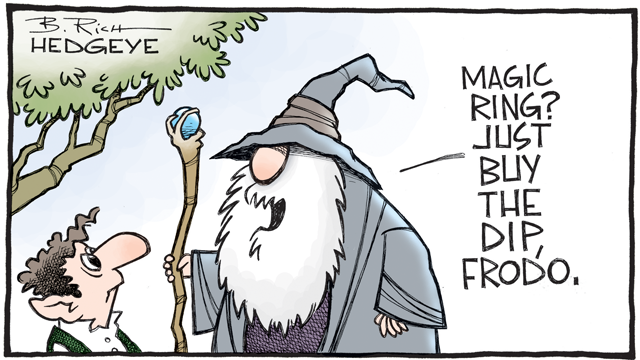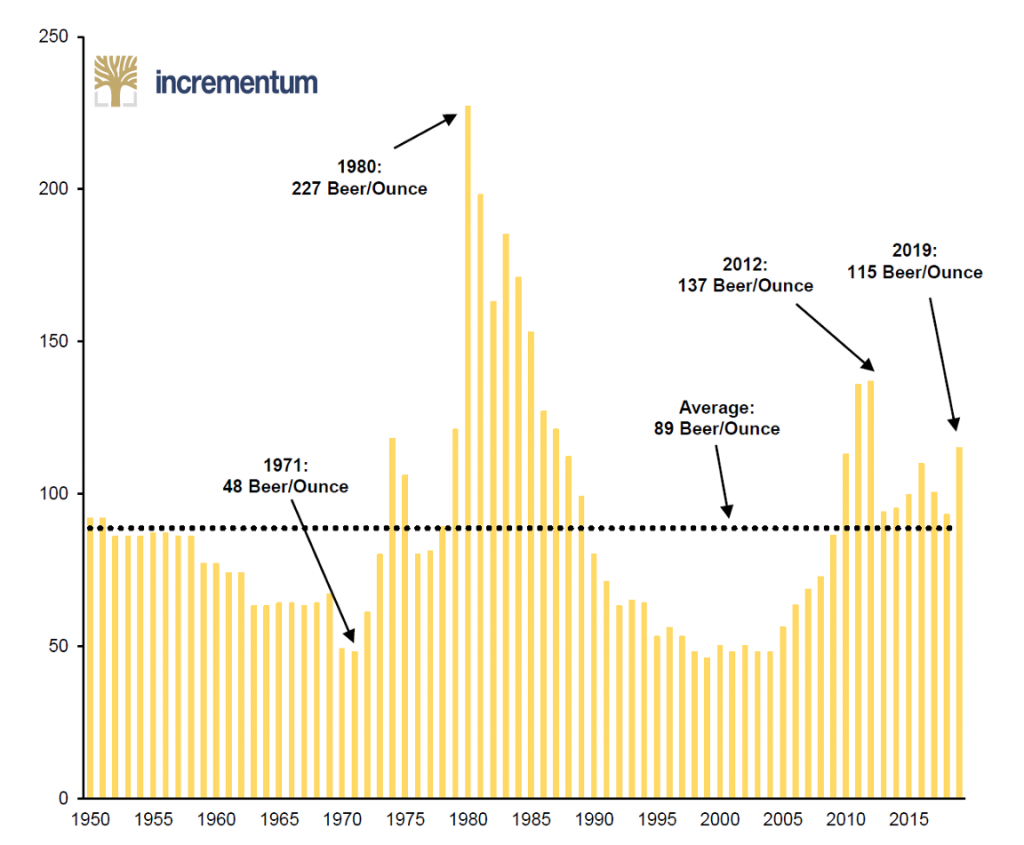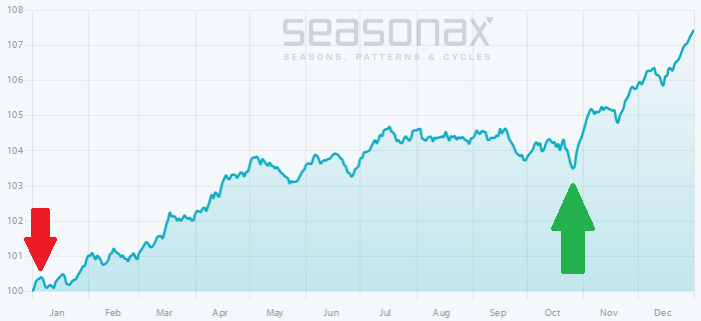A Shift in ExpectationsWhen discussing the outlook for so-called “risk assets”, i.e., mainly stocks and corporate bonds (particularly low-grade bonds) and their counterparts on the “safe haven” end of the spectrum (such as gold and government bonds with strong ratings), one has to consider different time frames and the indicators applicable to these time frames. Since Donald Trump’s election victory, there have been sizable moves in stocks, gold and treasury bonds, as the election result has strongly boosted certain market expectations. |
|
| The chart below compares three of the associated ETFs, namely SPY, TLT and GLD:
As we have mentioned late last year, US true money supply growth rates have accelerated sharply again. Since the stock market has concurrently broken out to new all time highs, its strength deserves some respect for now, despite the fact that valuations are extremely high. Our assessment is that there will likely be near term weakness, followed by medium term strength and ultimately a long term disaster. The “alarm bells” mentioned in the title of this post refer to the near term outlook. In a recent article on post election seasonality (see “Regime Change – the Effect of Trump’s Victory on Stock Prices” for details) Dimitri Speck has pointed out that there is a case to be made for near term weakness based on the market’s average performance in post-election years. The question is now whether the current technical, sentiment and fundamental backdrop is conducive to market action that is in line with this statistical average. |
SPDR S&P 500 ETF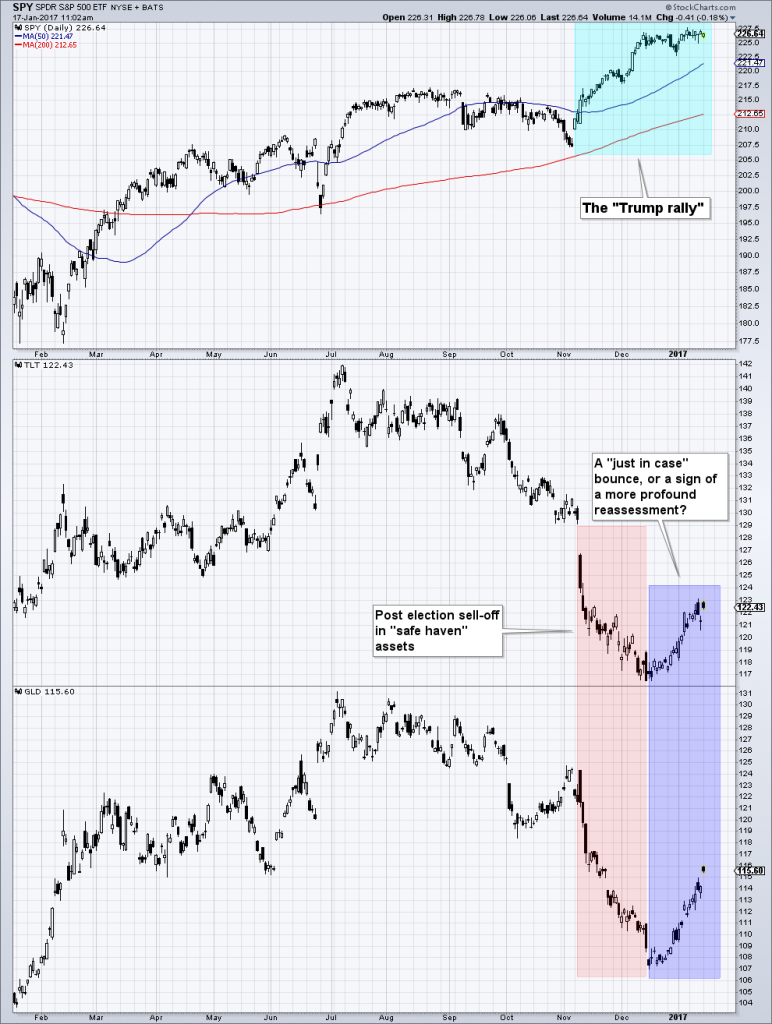 SPY, TLT and GLD – after the election, stocks rallied while treasuries and gold sold off. The main (but not only) driver of these moves were surging inflation expectations. Since mid December, treasuries and gold have quietly rallied though, in what seems to be widely considered a “technical bounce” one is usually advised to ignore (we won’t) - Click to enlarge |
| Inflation expectations have trended higher through most of last year (note: we are referring to expectations regarding the future rate of change of CPI – they have nothing to do with monetary inflation). This is quite rational for a number of reasons. First of all, headline CPI is almost certain to rise due to last year’s rally in energy prices. This is due to a statistical artifact (the so-called base effect), the main characteristic of which is its inevitability. |
Inflation breakeven rate |
| Secondly, there is a strong and not exactly unreasonable suspicion that most of the economic policies favored by the Trump administration (at least some of which will presumably be backed by the Republican-controlled legislature) are likely to push price inflation up. Higher government spending, tariff hikes, the possible deportation of cheap illegal workers, etc., are all deemed to lead to higher consumer prices.
Keep in mind in this context that the inter-temporal price distortions along the production structure triggered by the Fed’s loose monetary policy in recent years are fated to eventually shift and reverse anyway. Resources have been misallocated as too much has been invested in the higher stages of the economy’s capital structure relative to the lower stages. Eventually a bottleneck should emerge in terms of the demand for and supply of final goods, in conjunction with hitherto suppressed natural interest rates reasserting their influence on market rates. The problem is that the real savings needed to support and maintain a lengthened production structure never existed – they were an illusion created by the printing press. The same holds for the decline in consumer demand implied by an increase in savings – it simply hasn’t happened (at least not to the extent indicated by market interest rates). The real funding for long term investment projects still needs to come from somewhere though. It such investments are not supported by an increase in real savings, capital will be consumed. The falsification of economic calculation engendered by prices that have been distorted by credit expansion inter alia leads to the reporting of illusory accounting profits – later it turns out that capital maintenance has been lacking and the previously reported profits turn into very large losses (think about 2008/2009 as the most recent example of such an “unmasking”). At some point the capital consumption will be reflected by a surge in market interest rates and a shift in prices. Many of Trump’s policy proposals (if implemented) are likely to hasten this process, ceteris paribus. |
Industrial Production: Business Equipment/Consumer Goods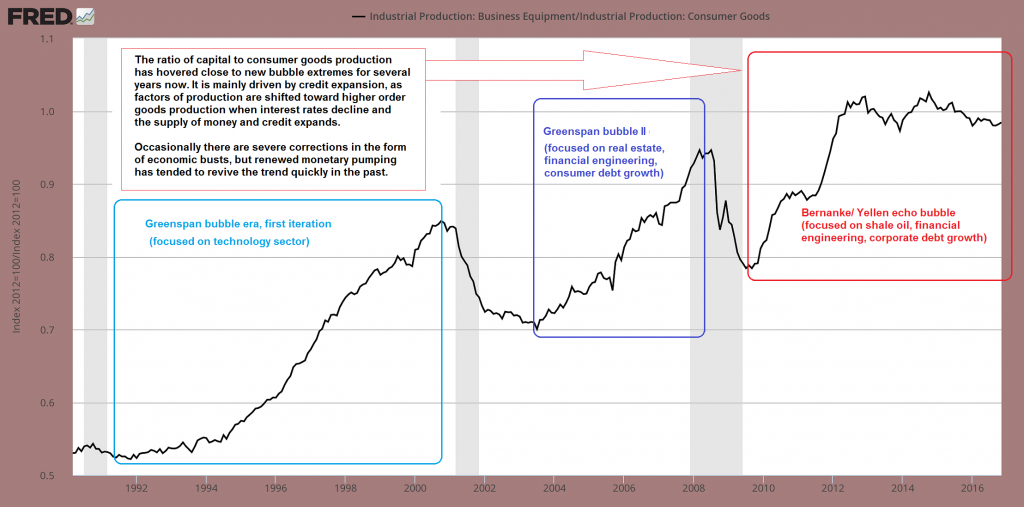 The ratio of capital goods to consumer goods production is a reflection of the policy-driven credit bubbles of recent decades. Currently the ratio is in a sideways channel at an extremely high level, as strong money supply growth and credit expansion have continued almost unabated since 2008. There is a natural limit to this trend though, provided the central bank does not opt for extreme inflation (we currently assume that it won’t, but this assessment may have to be changed in the future) - Click to enlarge |
New Positioning ExtremesWe can conclude from all this that the current positioning of speculators is at least partly justified, but their positions have become far too one-sided in the short term. We have already shown a brief chart overview in mid December (see “The Exiling of Risk”), that illustrates the strong investor consensus that has emerged since the election and the enthusiasm with which short term traders have joined the bandwagon. Recent developments in speculative positioning suggest that quite explosive counter-trend moves could be in store in the near term. We can once again report on new record highs in certain positioning data, which has almost become a tradition in this new era of unprecedented monetary policy extremism and the vast increase in systematic and fully automated trading. We never had occasion to use the terms “record high” and “record low” as often as in the past several years. This is an area in which some sort of “hyperinflation” is clearly underway. This time it concerns speculative positioning in treasury futures. Below is a chart of the net hedger position (the inverse of the net speculative position) in 10-year treasury note futures. It actually serves as a proxy for the entire curve, as speculators have taken record net short positions across they entire maturity spectrum, with the exception of the 30 year bond. Even euro-dollar net speculative shorts are at a new record high of more than 2,444,000 contracts (equivalent to approx. 726,000 10 year treasury contracts). Mish has a report on the details here. Net speculator positions in treasury futures overall are currently equivalent to $100 billion in terms of cash treasuries. What makes this unprecedented case of speculators eagerly piling into the same trade especially interesting is the speed with which it happened and that they have decided to ignore the fact that the trade has actually stopped working a month ago. Nearly every short position opened since mid December is under water by now, and yet, speculators keep enlarging these positions. But aren’t they correct in doing so? After all, it is a near-certainty that higher headline inflation rates will be reported in coming months. Moreover, even if the Trump administration only manages to implement a few of its policy proposals, upward pressure on price inflation will still result. We believe the main problem with this is that it is simply too obvious. What everybody knows already is usually not really worth knowing. Once we see such extremes in positioning data, we should actually ask “what could go wrong with the obvious scenario”. There are plenty of things that could go wrong – the possibilities include another crisis in the euro area (several critical elections are coming up), problems in China’s currency and credit markets, a budding trade war, a surge in geopolitical upheaval, and so forth. Why all these so-called tail risks are so studiously ignored all of a sudden is a bit of a mystery |
10 Year Treasury Hedgers Position |
Real Interest Rates and GoldA similar picture has emerged in the gold market: while speculators remain net long gold futures, their position has barely moved up from the one year low that was recently reached, despite the rally in gold prices. There are also other signs that sentiment on gold remains very cautious – so far the rebound seems to be met with plenty of disbelief, similar to what we can see in treasuries. Readers may recall that near the recent correction lows in gold and gold stocks, some sentiment measures indiacted that bearish sentiment had reached rarely seen extremes (see our missive from late December: “Gold Ready to Spring Another Surprise” for details on this). We will provide a more a more detailed update on the situation in the gold market in a separate post, but we want to show an update of one of the charts we discussed in the “fundamental drivers” section of the post mentioned above. As we have pointed out, the gold price at times leads changes in the trends of its fundamental macro-economic drivers. The gold market is for instance highly sensitive to future changes in market liquidity and the reaction of central banks to such developments. At times this involves very long lead times. In the short term, the gold price appears the be sensing incipient trend changes in real yields. Gold has a very tight inverse correlation with 5 and 10 year TIPs yields, but often it is actually leading them slightly (sometimes by just a few days). This has just happened again as the updated chart of 5 year TIPs yields illustrates: |
Constant Maturity |
Stock Market Internals and Risk AppetiteThe stock market itself actually still looks quite solid from a technical perspective – but not from a sentiment perspective. Confidence in a continued surge in stock prices has become way too pronounced, as sentimentrader’s “smart/ dumb money confidence spread” shows. |
Smart/Dumb Money Confidence Spread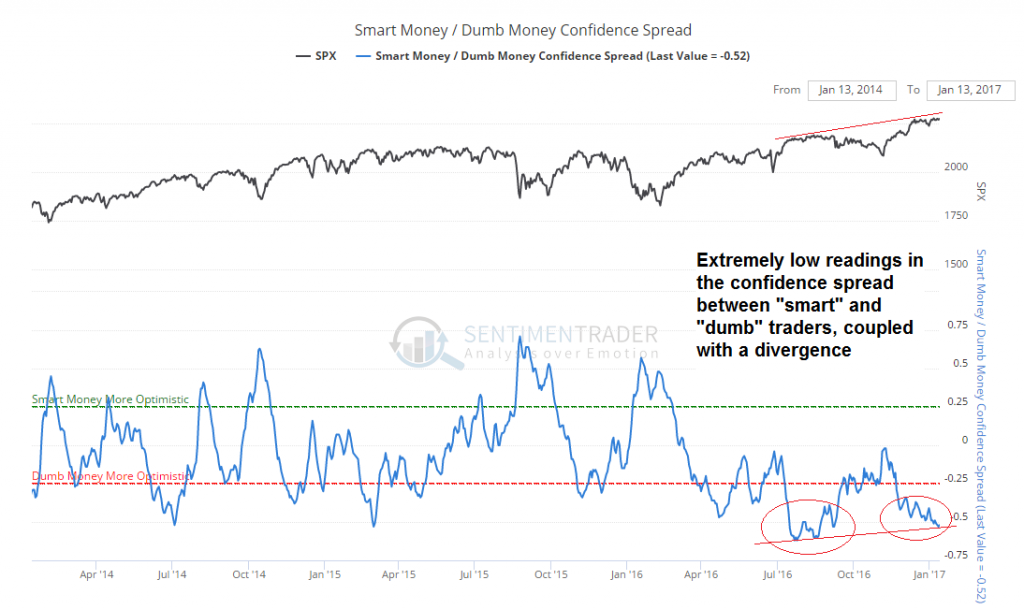 The smart/dumb money confidence spread has reached an extreme level again – which is actually diverging slightly from the one set in the summer months. Experience shows that such divergences often precede sizable corrections (if one studies the chart a bit, one can see several such instances actually – usually a higher low in the spread is put in place concurrently with a new high in stock prices or with stock prices retesting their previous highs). This spread is solely based on market data – it includes no surveys - Click to enlarge |
| While there are small divergences evident in a few market internals as well, they are not yet pronounced enough to give cause for concern – but that could change very quickly. The last two sizable corrections were preceded by warning signs in several internals, but they were not particularly pronounced and one had to pay close attention to notice them in good time. |
S&P 500 New Highs - New Lows Percent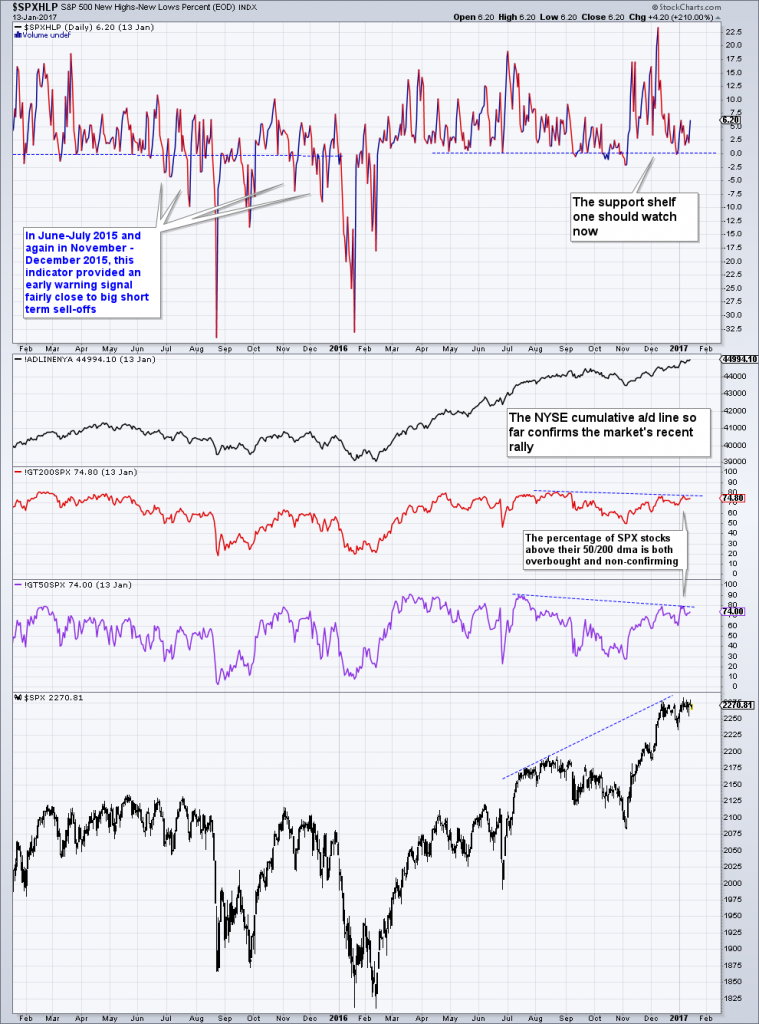 Market internals: a few small divergences with price are in evidence, but nothing major as of yet. The cumulative NYSE a/d line is still confirming the market’s strength, but one should keep a close eye on the “support shelf” consisting of the zero level in the NH/NL percentage spread - Click to enlarge |
| Someone once remarked to us that no bear market had ever begun while the cumulative NYSE a/d line still confirmed new price highs. That is actually not correct – while the a/d line and other internals usually do tend to diverge at major price peaks preceding bear markets, it does not always happen. A noteworthy exception occurred at the late 1937 market peak, which was confirmed by the a/d line, but was nevertheless followed by one of the fastest and steepest bear markets of the past century.
Below are two of the longer term indicators we follow. They usually have no bearing on the timing of short term market moves, but there have been a few recent developments worth mentioning. We already discussed the “Risk Appetite Index” in our mid December update. It remains at an extremely high level. |
SPX, Risk appetite index Compared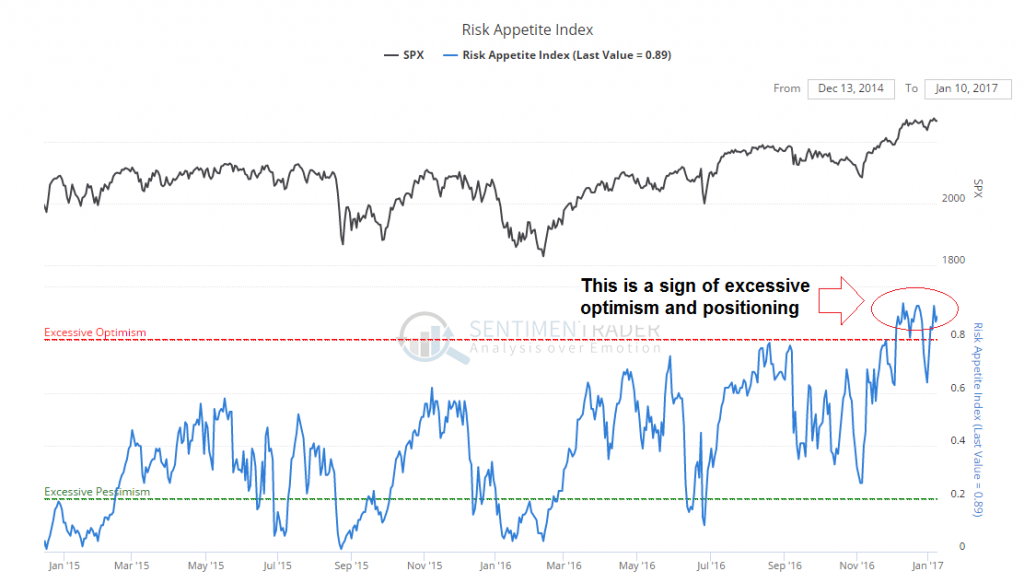 The sentimentrader “Risk Appetite Index”, a combination of the Citigroup Macro Risk Index, the Westpac Risk Aversion Index and the UBS G10 Carry Risk Index. Similar to the confidence spread shown further above, this index is solely based on market data and involves no surveys or other verbal or written expressions of opinions - Click to enlarge |
| What makes this so interesting is that after the person that was widely held to generate major “uncertainty” in the markets has become president of the US, market prices and positioning seem to indicate that certainty is greater than ever!
Zerohedge recently reported that the Goldman Sachs version of the risk appetite index has actually reached a new record high. The previous all time highs in this particular index were posted at the market peaks in 2000 and 2007, which are somewhat ominous precedents. The mutual fund cash-to-asset ratio has finally also reached a new all time low of 3.1% at the end of 2016 (here we go again with the records!). It previously touched the former record low of 3.2% several times and has in the meantime ticked back up to that level. The persistently low level of this ratio in recent years represents the longest stretch of record or near record low readings in the history of the data (which begins in 1955). |
SPX, Mutual Fund Cash Level Compared |
| As mentioned above, this indicator is not useful for forecasting the timing of near term corrections. Similar to extremely high valuations, all it is telling us is that the market’s long term returns are likely to be very poor.
Lastly, the VIX – a measure of the implied volatility of S&P 500 index options – also shows that complacency is quite pronounced at the moment. This is likely to be relevant for the market’s near term outlook, especially in view of the fact that speculators currently hold near record net short positions in VIX futures as well (129,000 contracts net as of the most recent CoT report– the record high posted in September 2016 was 138,000 contracts). |
VIX Volatility Index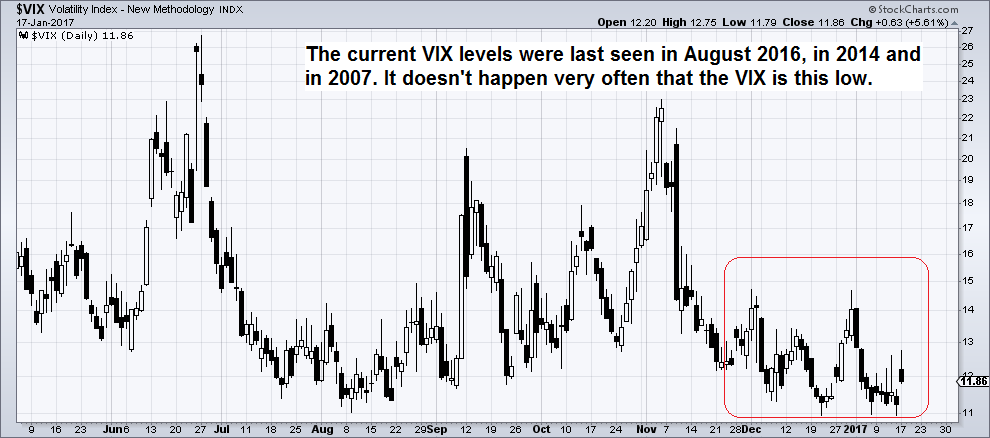 The VIX shows that investors are quite complacent – and it is accompanied by an extremely large net speculative short position in VIX futures as well, yet another vehicle that has broken a number of records in the past few years. Extremely low implied volatility as a rule tends to be followed by very high realized volatility - Click to enlarge |
Conclusion
The recent extreme in net speculative short positions in treasury futures is a warning sign for risk assets – while it is per se not a bullish indicator for bonds, it makes treasury notes and bonds very vulnerable to a sizable upside correction. This is also confirmed by a decline in the five day average of the DSI (daily sentiment index of futures traders), which stood at only 9.8% bulls in early January.
Traders have so far largely ignored the quiet advance in treasuries and gold since mid December, which makes these rallies all the more intriguing. At the same time we see risk appetite indicators at or near record highs, while confidence regarding the trend in stock prices among the groups of traders most likely to be wrong is extremely high. Incidentally, the combined dollar-weighted net speculative long position in stock index futures is right at the upper end of its multi-year range as well.
While stock market internals are more or less still neutral at this stage, such extremely one-sided speculator positioning (recall also recent NAAIM survey data) should not be ignored. If any unexpected fundamental news should emerge that throw doubt on the beliefs so widely held by market participants of late, a sizable surge in market volatility is likely to ensue.
Charts by: SentimenTrader, StockCharts, St. Louis Federal Reserve Research
Full story here Are you the author? Previous post See more for Next post
Tags: Chart Update,newslettersent,On Economy,The Stock Market











